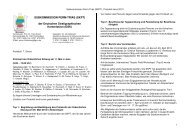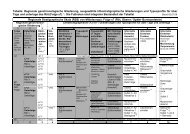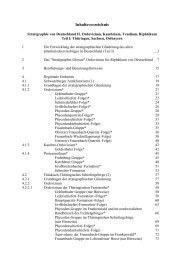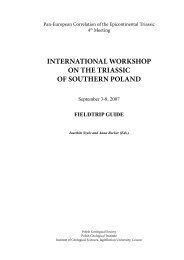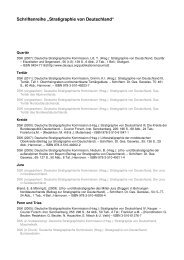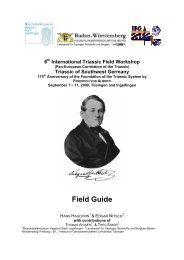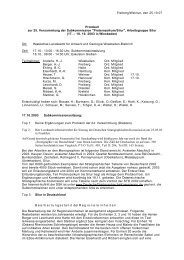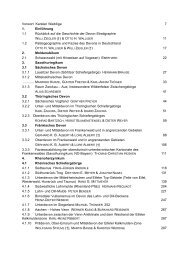International Field Workshop on 'The Triassic of eastern France'
International Field Workshop on 'The Triassic of eastern France'
International Field Workshop on 'The Triassic of eastern France'
You also want an ePaper? Increase the reach of your titles
YUMPU automatically turns print PDFs into web optimized ePapers that Google loves.
IV. The Keuper<br />
IV.1. - Geological setting<br />
Classically, two areas <strong>of</strong> sedimentati<strong>on</strong> have been distinguished in the Keuper <strong>of</strong> the Paris Basin.<br />
These are an <strong>eastern</strong> area c<strong>on</strong>sisting essentially <strong>of</strong> halitic or anhydritic coastal sabkha deposits and a western<br />
area dominated by fluvial deposits (Dubois and Umbach, 1974; Courel et al., 1980; Matray et al., 1989). The<br />
Saint-Martin de Bossenay fault divides these two areas (Bourquin and Guillocheau, 1993, Fig. III.2). The<br />
Norian as never been dated in the <strong>eastern</strong> Paris Basin.<br />
IV.1.1. - Lettenkhole<br />
In the <strong>eastern</strong> part <strong>of</strong> the Paris Basin, the first facies attributed to the Keuper are characterized by<br />
dolomites and clays <strong>of</strong> the Lettenkhole. The age <strong>of</strong> this unit is well established in the <strong>eastern</strong> part <strong>of</strong> the Paris<br />
Basin (Fig. I.1): the Middle Lettenkohle is Upper Ladinan (Kozur, 1972; Adl<strong>of</strong>f et al., 1984) and the<br />
‘Dolomie limite’ is Lower Carnian (Kozur, 1972). These strata are equivalent to the Lettenkeuper deposits <strong>of</strong><br />
the German Basin (Gall et al., 1977). The Lettenkohle, which crops out in the <strong>eastern</strong> part <strong>of</strong> the Paris Basin,<br />
is composed <strong>of</strong> dolomitic-clayst<strong>on</strong>es and dolomites overlain by an anhydrite bed. It was deposited in a<br />
restricted marine envir<strong>on</strong>ment (Courel et al., 1980; Duringer and Doubinger, 1985). The upper part <strong>of</strong> the<br />
Lettenkohle ‘stage’ is characterized by lago<strong>on</strong>al-marine facies (Ainardi, 1988), followed by more marine<br />
dolomitic clayst<strong>on</strong>es which accumulated during maximum water depth.<br />
IV.1.2. - Marnes irisées<br />
The ‘Marnes irisées’ Group is divided in three parts: the ‘Marnes irisées inférieures’, ‘Marnes irisées<br />
moyennes’ and the ‘Marnes irisées supérieures’ (Table 1 and Fig. I.1).<br />
In the east <strong>of</strong> the Paris Basin, the ‘Marnes irisées inférieures’ are made up <strong>of</strong> evaporite coastal sabkha<br />
deposits (Fig. I.1): the ‘Couches à pseudomorphoses’ (anhydritic shales), ‘Formati<strong>on</strong> salifère’ (halite and<br />
shale) and ‘Couches à esthéries.’ The base <strong>of</strong> the ‘Formati<strong>on</strong> salifère’ in Lorraine is dated as Lower Carnian<br />
(Kozur, 1972; Geisler et al., 1978). These evaporite series occurred at remarkably similar times throughout<br />
the <strong>Triassic</strong> basins <strong>of</strong> western Europe, where halite deposits may be several hundred metres thick. This major<br />
<strong>Triassic</strong> evaporite ‘crisis’ corresp<strong>on</strong>ds to the ‘Unterer-Gipskeuper’ (Grabfeld Formati<strong>on</strong>) in the Germany.<br />
The ‘Marnes irisées moyennes’ are composed <strong>of</strong> three formati<strong>on</strong>s: the ‘Grès à roseaux’, the ‘Argiles<br />
bariolées intermédiaires’ and the ‘Dolomie de Beaum<strong>on</strong>t’ formati<strong>on</strong>s (Table 1 and Fig. I.1).<br />
In the Germanic Basin, evaporite sedimentati<strong>on</strong> was suddenly interrupted by the spread <strong>of</strong> fluvial<br />
deposits forming the most c<strong>on</strong>sistent lithostratigraphic marker <strong>of</strong> the entire basin: the ‘Schilfsandstein’<br />
(Dittrich, 1989) and ‘Grès à roseaux’ <strong>of</strong> northeast France (Fig. I.1). This unit is dated as Middle Carnian<br />
(Julian) (Kannegieser and Kozur, 1972; Kozur, 1993) and must have been deposited during a relatively short<br />
time (Hahn, 1984). Correlative units have been identified in several other basins: ‘Arden Sandst<strong>on</strong>e’ in Great<br />
27



